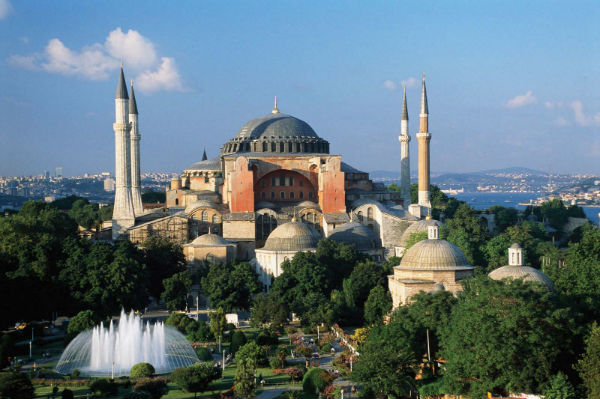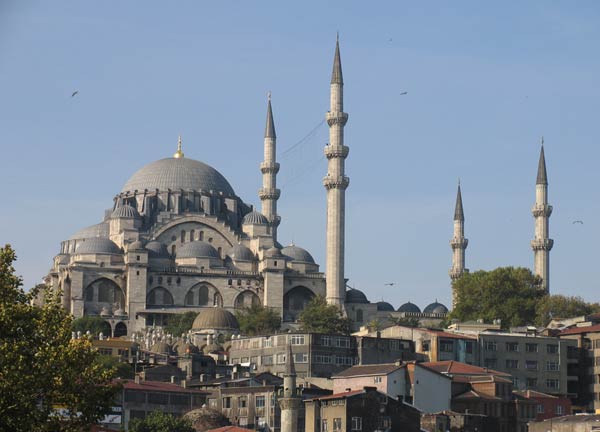Day 1. We offer a perfect start with a delightful walk of the Palace of the Sultans – Topkapi palace complex located in the most extreme point of the Istanbul peninsula, on the hill surrounded by the waters of the Bosporus and the Marmara Sea. Even at the entrance to the “Cannon Gate” of the palace you can meet a centuries-old beauty such as trees-giants and fortified walls protecting the palace from all sides. For almost four centuries this town within a city served as the residence of the sultans. You can see everything once touched by sultans in the numerous halls, pavilions, treasury, armory and mosques. Priceless gifts of rulers of various countries, luxury ceremonial outfits and weapons, the walls of pavilions which are also works of art – all this can be seen inside the palace complex. You can also see the Muslim shrines that belonged to the Prophet and his family in Islamic prayer halls. You can visit the Harem – a complex of buildings built near the sultan’s palace because of Roxelana, the concubine of the sultan, who wanted to be closer to her beloved Sultan Suleiman I. Mother of sultan, Valide Sultan ruled at the mentioned “female kingdom”. The harem has been a secret and hooded place for hundreds of years. But now it is open to the world.
The next historic building in our journey is Rustem Pasha Mosque. It was named after the son-in-law of Sultan Suleiman the Magnificent. Rustem Pasha organized and paid for the construction of this mosque. The architect was quite unusual man – Mimar Sinan, “the architect who didn’t not need architectural planning. Constructing the Rustem Pasha Mosque located in the heart of the historic district of Eminonu, Sinan used porcelain tile, a characteristic pattern of Ottoman art. The mosque is covered with ornate tiles with floral motifs mainly of blue colors and shades up to the dome. Portico for latecomers, columns, arches and fountains – all these elements make the architecture of the mosque special and unseal. Afterwards we’ll head to the inspiring Bosporus. It is the thread that connects the ancient world and the present day. Its shores are Europe and Asia looking at each other. In translation, Bosporus means “bull’s ford”. The name comes from Greek myth about beautiful Io transformed in white cow by Zeus escaped the wrath of Hera swimming through the Bosporus.
Walking along the Bosporus with palaces, mosques, houses of the Ottoman period and modern buildings on the banks. You can find the oldest sailing ship of Turkey – “Amerigo Vespucci” – straight in the strait. Bridge abutments connecting Europe and Asia are towering to the clouds. The Two Towers situated on opposite banks of the narrowest point of the strait reminiscent of the great conquest of Constantinople while palaces overlooking the waters of the passage talk about the splendor of court life in Porte.
After a stroll along the Bosporus, we will head to the largest mosque in Istanbul built by Sinan Mimar – Süleymaniye. It was built by order of Sultan Suleiman I the Magnificent. Süleymaniye Mosque was created by Sinan being inspired by beautiful Hagia Sophia. But Süleymaniye is not just a room for prayers: a complex of buildings occupies almost an entire city block. It includes madrasah, shelter, baths, hospital, caravanserai for guests where visitors were fed for free for three days. The building of the mosque is one of the most earthquake-resistant ones in spite of the huge dimensions; for almost five hundred years of the history the building has survived numerous earthquakes (almost) without loss and damage. Mimar Sinan said that “the mosque will stand forever”. Many legends are connected with the construction of the Süleymaniye. Sultan Suleiman I the Lawgiver, his beloved wife – the daughter of an Orthodox priest Roxelana and great architect Mimar Sinan are buried in the cemetery behind the mosque.
Next mosque is the first famous building erected by Mimar Sinan in Istanbul. The mosque is built on the order of Sultan Suleiman and is dedicated to the heir to the throne, son of Suleiman Şehzade Mehmed who died of smallpox. Hence the name of the mosque – Şehzade or the Heir’s Mosque. Monumental architecture of the mosque is a reminiscent of the outline and contours of Hagia Sophia. Like the rest of Mimar Sinan’s mosques, Şehzade stands on the foundation filled with water. Light stone walls, windows, arches and niches in pointed shape give the mosque airy appearance. In contrast with the smooth and plain exterior walls. interior of the mosque is decorated with solemn granite columns, bright stained-glass windows and elaborately carved woodwork. Numerous windows and bright colors of inner trim give the illusion of soaring dome. There is the mausoleum of Şehzade Mehmed, his brother Şehzade Jihangir and two grand viziers – Rustem Pasha and Mustafa Desteri Pasha at the cemetery of the mosque.
The first sightseeing day comes to an end.
Day 2. On the second day of sightseeing we will get familiar with the center of the historic part of Istanbul.
Let’s start with a walk along the hippodrome area (Ahmediye). The racetrack was established in 203 BC under the Roman rule when the city still was called Byzantium. In the IV century BC Emperor Constantine the Great completely rebuilt the racetrack. The famous Venice quadriga was taken from the Constantinople Hippodrome in XIII century. Sports and gladiator fights held here were the cause of mass unrest and riots of violent fans. In Ottoman times, the hippodrome was used only for folk festivals, fairs and amusements. Since the Byzantine emperors the hippodrome became the site of placement of the historical objects: the Egyptian obelisk from Luxor with images of great deeds of Pharaoh Tuthmosis II brought by Emperor Theodosius in the IV century BC to Constantinople; the heavily altered Obelisk of Constantine (the gold plates of the times of the Crusaders were stolen); Serpentine Column, the former fountain brought from the temple of Apollo at Delphi. Later the fountain was founded on the square as a gift to the city from the German Kaiser Wilhelm II. Approaching closer to the water source you will see the fascinating beauty of fountain decorations: the gilded dome shimmers in all colors that decorate the interior walls of the fountain.
In the unremarkable building situated not so far from the Ahmediye square is hidden underground reservoir of Erebatan (Basilica Cistern). Going downstairs, we will find ourselves in a very unusual space. Reservoir built by Greeks and used for thousands of years, have been abandoned and forgotten by nearly five hundred years. Now fish is swimming in the waters of ancient cistern, water-resistant columns of ancient temples are still supporting the vaulted ceilings of Erebatan and giant inverted heads of mythical Medusas are situating under these powerful pillars for more than one and a half thousand years. There is a column that helps the cherished wishes to come true.
We will complete our tour of the Istanbul visiting Hagia Sophia. There is no other such spiritual and heartwarming space in whole Istanbul. Hagia Sophia was the first of the magnificent buildings of the Christian world. It was built in the IV century BC during the reign of Constantine the Great and was reconstructed, destroyed and rebuilt again for many times. After the capture of Istanbul in 1453, it became a mosque and appeared to be the museum since the times of the Father of the Turks, Mustafa Kemal. But the place hasn’t lost its spirituality yet. The simplicity and monumentality, Orthodoxy and Islam, openness and mystery – you will so much confusions in the Hagia Sophia. The mosque has preserved mosaics with Christian scenes looking at every person entering inside and pulling his eyes towards the sky, towards the God. The mosque has also preserved the texts of the Holy Quran. People are detecting unknown pentagrams carved in marble throughout the mosque which are still not decoded by scientists. You can distinguish the antique crosses and patterns on the walls, under the ornamental details. Floral Byzantine motifs, Arabic script and archangels hidden but not destroyed in times when Aya Sofia became a mosque – all of them are harmoniously coexisting in the divine Museum called Hagia Sophia.




